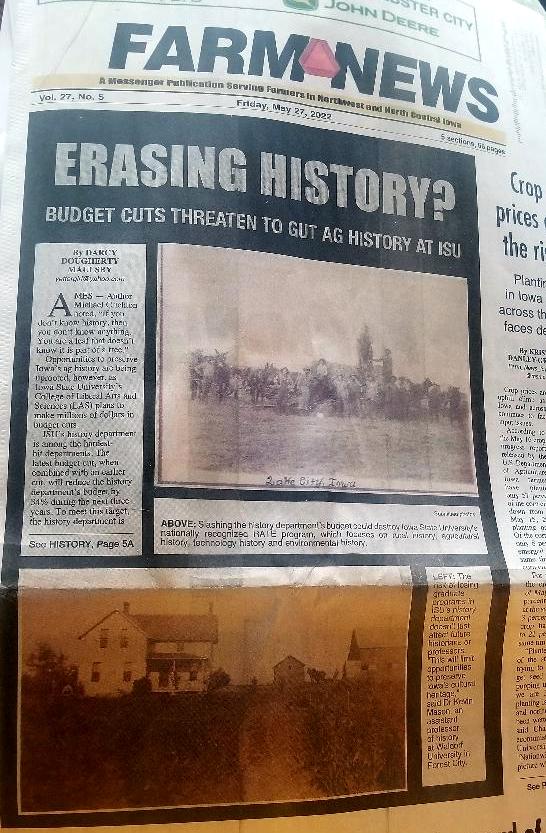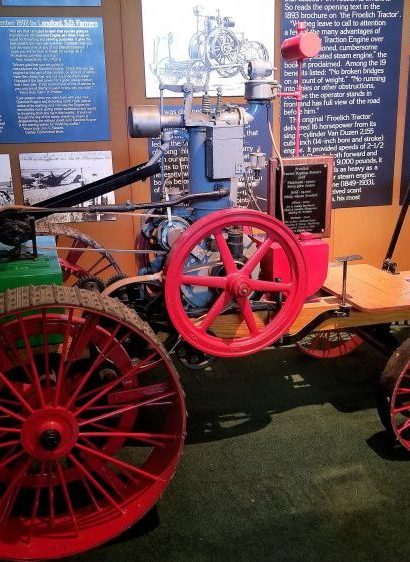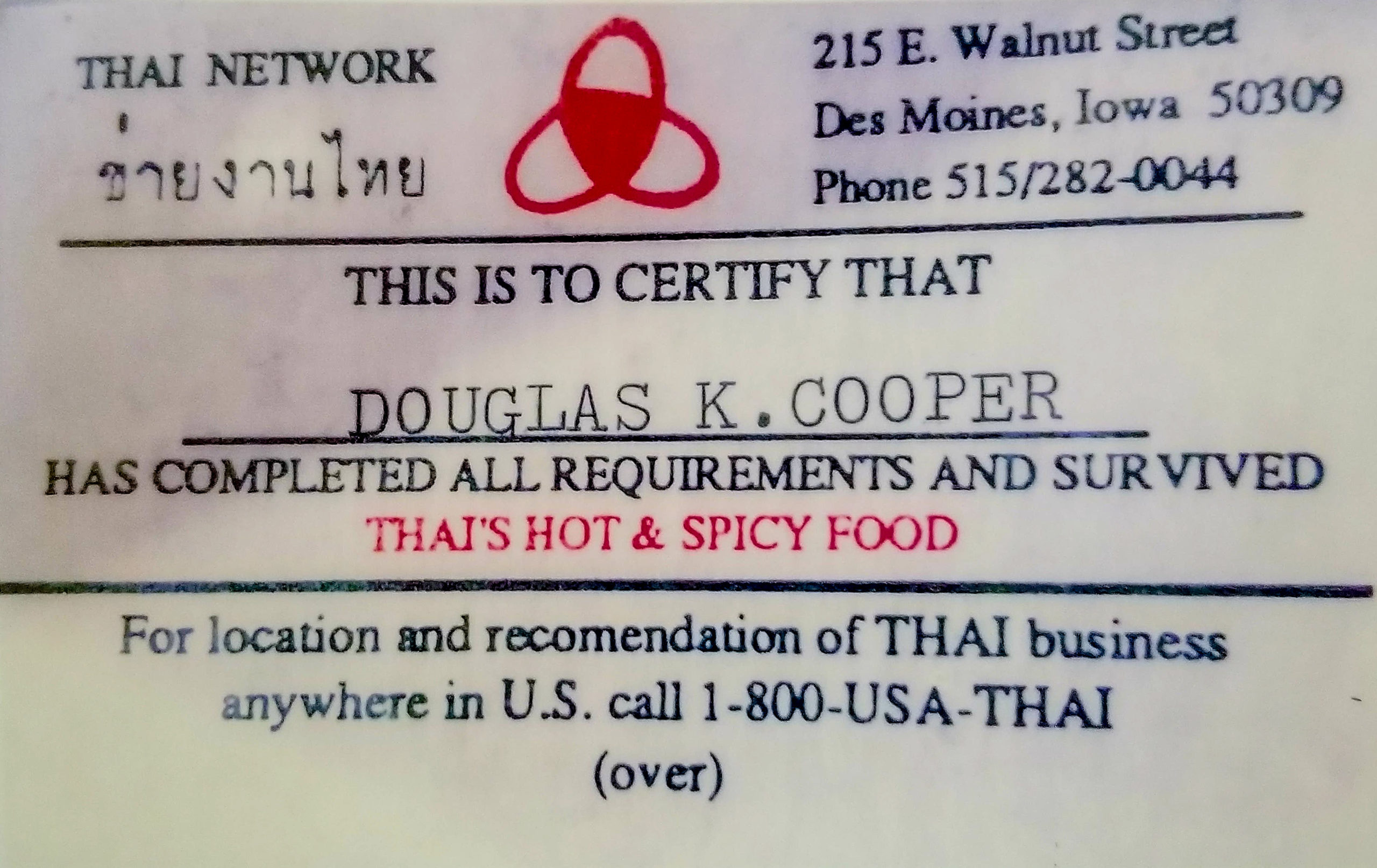Category: Communication Tips

Always Alert-How to Stay Safe in Any Situation
What was that? None of us knew what was going on at first, and I was confused—and alarmed.
It happened on the bright, sunny morning of October 16, as hundreds of us were gathered at 9 a.m. in the ballroom of the downtown Marriott Hotel in Des Moines for the Iowa Hunger Summit. I thought this would just be another routine meeting to cover. Boy, was I wrong.
After opening remarks from Ambassador Kenneth Quinn, president of the World Food Prize Foundation, and Iowa Farm Bureau Federation President Craig Hill, five former U.S. Department of Agriculture secretaries (including Tom Vilsack, Ed Schafer, Mike Johanns, Ann Veneman, and Dan Glickman) stepped on stage for a panel discussion. (You can read my recap of the panel discussion in my article “Hungry for Answers” in Farm News.)
Suddenly there was a ruckus from the back of the ballroom. There were voices shouting, although I couldn’t make out the words at first. Everyone began looking around to see what was going on. Was this a surprise part of the program?
Suddenly a small group of young men holding a large white banner painted with red lettering marched down the aisle. It soon became evident they were chanting about “hell no GMOs” over and over. A slender young woman dashed after them, capturing the footage on her cell phone.
It also became clear this group intended to stand between the bewildered audience and row of former ag secretaries on stage, as the protestors belted out their angry chant. I don’t know exactly how long the group took over the Iowa Hunger Summit, but it seemed much longer than it probably was.
It appeared that most of the audience, myself included, froze in shock, desperately hoping someone would take control of the situation.
Finally, a tall gentleman dressed in a business suit demanded that the protestors leave, herding them at times towards the side exit doors, since the group showed no signs of leaving voluntarily. One protestor nearly knocked over Iowa Public Television’s camera near the side of the stage as he and his cohorts continued shouting.
The spectacle didn’t come to an end until the protestors turned to face the audience as they were escorted out of the side doors, bellowing, “Shame, shame, shame” all the way.
While I breathed a big sigh of relief as the Iowa Hunger Summit proceeded without incident, I couldn’t help but think about the mass shooting in Las Vegas just days before. I also started thinking how vulnerable all of us were in that ballroom, if the worst had happened.
What if the worst had happened?
I started researching personal safety and situational awareness and am now rethinking the way I view the world. In many ways, these safety tips boil down to the power of observation, a tool I use daily as a writer and encourage you to use, as well.
• Think ahead. A 2014 study from the Federal Bureau of Investigation (FBI) found that most active shooter events end in 2 minutes or less. This means you have little time to think if you’re caught in this situation. You’ve got to have a plan ahead of time, since you may only have seconds to act.
• Know your natural tendencies. When any sort of emergency arises, be it an active shooter or even a fire, the natural response for most people, surprisingly enough, is to not do anything. It’s human nature to freeze up in emergency situations. Another bias that keeps us from taking action is our natural tendency to follow the crowd. If we see that everyone else is locked up by inertia, we tend to act the same. Be aware of these forces, and prepare to counteract them.
• Visualize for safety. When you enter a public space, whether it’s a hotel meeting room, restaurant, airport, theater or other venue, take note of the exits. Also, put yourself in position so you can observe as much of your surroundings as possible. Try to sit with your back against the wall, for example, not the larger room where someone can come up behind you.
• Stay in “condition yellow.” This means you’re relaxed but always alert. Remaining aware of your surroundings will give you a head start if an emergency arises. Some safety experts call this ABO (Always Be Orienting). Don’t get so absorbed in your smartphone, for example, that you fail to pay attention to the world around you.
• Establish baselines and look for anomalies. Know what’s normal in a given situation. If something seems out of the ordinary, keep an eye on it.
• Play the “A” game. The “A” game, or awareness game, means you take note of details everywhere you go, from the gender, hair color and clothing of the person behind the counter at the convenience store to the number of exits you see in the theater. This game trains you to be mindful of your surroundings and can help you create a plan of action wherever you go.
• Call 911. If you find yourself in the midst of an emergency, get to safety as soon as possible, and then call 911. Don’t assume someone else already has.
It takes practice to truly pay attention to what’s going on around you, but this skill can a long ways in keeping you from appearing like an easy target. You want to get to the point where situational awareness is just part of your daily routine, much like looking both ways before you cross the street.
Don’t be paranoid, just mindful. Honing your powers of observation will pay big dividends and might even save your life.
Want more?
Thanks for stopping by. I invite you to read more of my blog posts if you want more intriguing Iowa stories and history, along with Iowa food, recipes and tips to make you a better communicator.
If you like what you see and want to be notified when I post new stories, be sure to click on the “subscribe to blog updates/newsletter” button at the top of this page. Feel free to share this information with friends and colleagues who might be interested, too. Talk to you soon!
P.S. Thanks for joining me. I’m glad you’re here.
@Copyright 2017 Darcy Maulsby & Co.

6 Ways to Motivate Yourself to Write—Even When You’re Not in the Mood
Seems like hardly a week doesn’t go by when someone asks me about how to get published or how to muster enough discipline to write in the first place. Since I think I have a touch of attention-deficit/hyperactivity disorder (ADHD), I rely on 6 methods that may seem a bit unorthodox, but they work. (By the way, they also work for other areas of your life, not just writing.)
1. Think in terms of wealth. Your discipline will begin to kick in the moment you embrace the idea that writing is the basis of all wealth. This may or may not mean monetary wealth. Depending on the project, wealth might mean a paycheck. In other cases, wealth might mean sharing valuable ideas that help others, or simply enjoying the therapeutic process of putting ideas in a tangible form.
2. Call b.s. on writer’s block. Trust me—writer’s block is a myth. It doesn’t exist. Writing is an extension of thinking, so if you’re struggling, it’s not writer’s block; it’s thinker’s block. Stop blaming your lack of creativity and productivity on some mysterious, external force over which you have no control.
3. Prime the pump. If you have thinker’s block (and I definitely do from time to time), you’re not reading enough. You’re not listening enough. You’re not asking enough questions. You’re not making time every day to think. You’re not feeding your curiosity. Develop a mindset to perpetually hunt for insight. Even if I only have a few minutes to read each day, I explore everything from content marketing books to non-fiction history to biographies of serial killers—whatever strikes my fancy. Not only does this spark my motivation to write, but it helps me collect stories, catchy phrases, quirky quotes and memorable metaphors. I save all these gems in a “swipe file” (a basic, simple Word document) that I tap into to jump start the writing process.
4. Chill out and rest. I’m the first to admit I’m horrible at this. I’m trying to do a better job of getting my full 9 hours of sleep a night for greater focus and mental alertness during the day. (Yep, my body does best with 9 hours. Your body will tell you what works best for you.) Also, when I make time during the week to unplug and space out for a little while, my brain recharges and gives me a new shot of writing motivation. Fantastic, isn’t it, that building healthy breaks is essential to writing? You now have my permission to go take a nap.
5. Just do it for 10 minutes. Often the hardest part of any writing project is just getting started. Challenge yourself to write for 10 minutes. That’s it. Just 10 minutes. If you’re like me, I bet you’ll pick up some momentum fast, and you won’t want to quit. Even if you do stop at 10 minutes, you’ve still made progress. Way to go!
6. Lower your standards. For a recovering perfectionist like me, it has taken a lifetime to learn this. (I’m still working on this lesson, by the way.) Perfect is the enemy of good, and a good writing project completed is vastly superior to a perfect writing project that exists only in your head.
I hope these tips help you on your journey to becoming a better communicator. If you have any tips that have worked for you, let me know. Write on!
P.S. Thanks for joining me. I’m glad you’re here.
@Copyright 2017 Darcy Maulsby & Co.
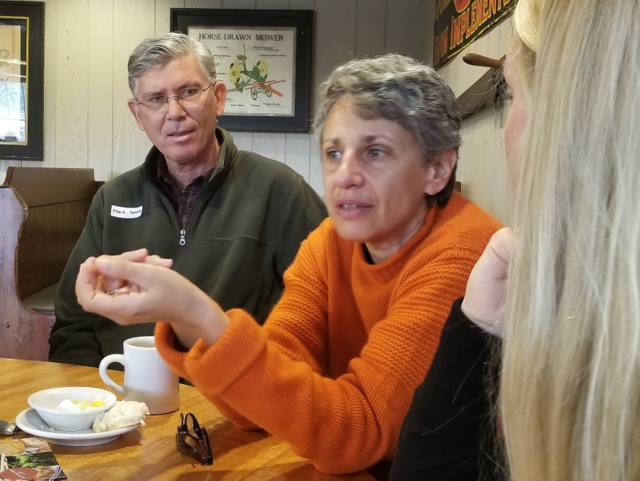
6 Steps for More Effective and Less Confrontational Conversations!
When was the last time you changed your mind? Not about something fairly inconsequential, like what to eat for supper tonight, but about a pivotal issue where you took a stand but later changed your mind?
Probably not lately. Maybe never.
It was an intriguing question posed by fellow writer Tamar Haspel–a question that still has me pondering its ramifications a few weeks after Haspel’s visit to Iowa.
“Many people go into conversations about food and agriculture with the expectations of changing others’ minds,” said Tamar Haspel, a Washington Post columnist who accepted the Iowa Food and Family Project’s invitation to tour Iowa farms in late September and learn more about Midwest agriculture. “We need to stop talking past each other.”
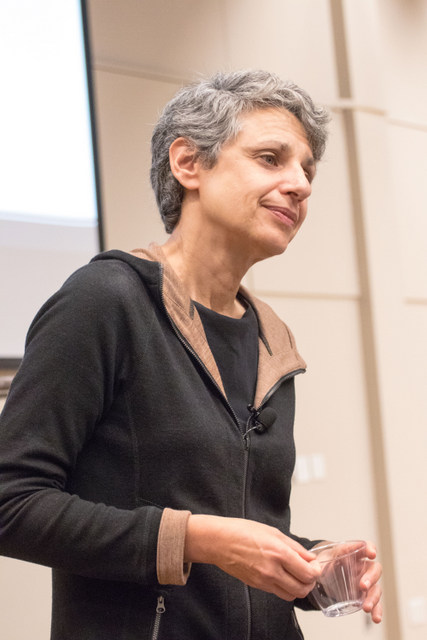
Tamar Haspel provided plenty of food for thought during her lecture about Iowa food and farming–and how to have more productive conversations about these topics–during a late September presentation at Drake University in Des Moines.
Yes, we need to stop talking past each other, I thought after Haspel uttered these sentiments during a breakfast meeting at the Iowa Machine Shed. It appeared that a lot of of the other ag leaders around the table with me were thinking the same thing.
If we believe we need to stop talking past each other, we need to understand more about how humans make decisions. Scottish philosopher and historian David Hume figured it out more than 200 years ago, Haspel noted, when he stated that reason is merely the “slave to the passions.”
“Why are we so bad at evaluating evidence?” asked Haspel, who is a Cape Cod oyster farmer and award-winning journalist who covers food supply issues, including biotech, pesticides, antibiotics, organics, nutrition and food policy.
Blame the confirmation bias, the human tendency to search for, interpret, favor and recall information that confirms one’s preexisting beliefs.
“Think about where the presets are on your car or truck radio,” said Haspel, who spoke at Drake University to approximately 50 people, including myself, on Sept. 27 during a public forum hosted by the Iowa Food and Family Project. “Think of the news sources you turn to and the people you follow on social media. All of us tend to live in our silo surrounded by people who think like us.”
How does all this play out with food and agriculture? Consider the facts. Farmers are mostly rural (no surprise) and Republican, based on campaign contributions reported to the Federal Election Commission. Activists and journalist are almost the exact opposite in these areas, Haspel said.
“This means farmers, activists and journalists are coming at food and agriculture issues with two completely different sets of values,” Haspel added.
6 steps for more effective conversations
This also means facts alone often aren’t persuasive. “So how do we communicate about food and farming? There are no good answers,” Haspel acknowledged.
Still, she offered six key steps to foster better communication, especially regarding food and agriculture topics:
1. Be persuaded that dynamics like the confirmation bias are real. While people often feel like they are rational human beings, everyone is susceptible to less-than-rational thinking. It’s time to re-evaluate the nature of certainty. “Are you right about everything?” Haspel asked the audience, who chuckled at the question. “So what aren’t you right about? It’s very difficult for us to spot where we go wrong, yet it’s easy to spot where others go wrong.” Two key questions keep Haspel awake at night as she strives to address her confirmation biases. “What do I get wrong? What am I not seeing? When you ask these questions, you go out into the world a little more circumspect,” she said.
2. Reconsider bias. Not only does everyone have biases, but bias is a necessary part of the human condition, Haspel said. “Expecting people to be objective is unfair.”
3. Drop “anti-science” from your vocabulary. “There’s science to say anything,” Haspel said. “When this plays out in the GMO debate, saying, ‘You’re anti-science’ translates as ‘you’re an idiot and I’m not.’”
4. Vet your sources. Assess the credibility of news sources, and seek various points of view. “I try to make sure my Twitter feed has lots of people I don’t agree with, along with people I agree with,” Haspel said.
5. Acknowledge truth on both sides. During her tour of Iowa farms, Haspel observed how many farmers feel beleaguered and lead with their defense. She also understands where this mindset comes from, as some audience members at Drake quizzed her about whether large-scale farming changes farmers’ motivations and turns agriculture into a profit-driven operation only. Other audience members questioned farmers’ commitment to protecting water quality and stressed the need for more regulation. “I talked with Iowa farmers who are definitely stewards of the land,” Haspel said. “But are there farmers who aren’t doing it right? Yes, there’s a minority for whom these criticisms apply. Since there is justice in some of the criticism, maybe that can help us find some common ground.”
6. Find intelligent people who disagree with you, and listen. “It’s so easy for us to talk to people who agree with us,” Haspel said. “I try to find the smartest person I know who doesn’t agree with me, and I listen carefully.”
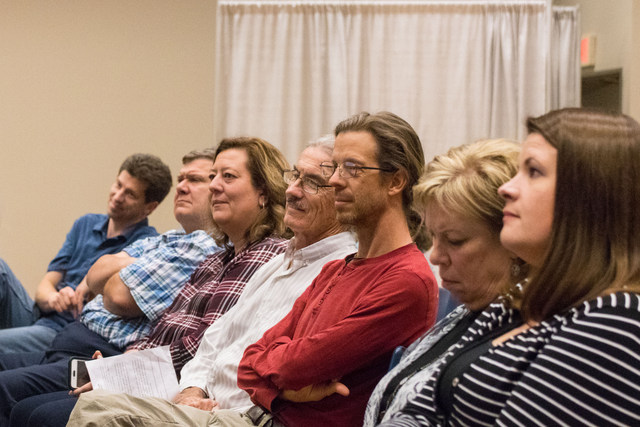
Audience members at Drake University in Des Moines, including Iowa Turkey Federation Executive Director Gretta Irwin (third from left) pondered Tamar Hapels’ 6 tips on more effective conversations involving food and ag topics.
Opening minds, acknowledging truth
I was fascinated by what I was hearing. I also wanted to talk this through with a colleague who attended Haspel’s lecture. I reached out to Gretta Irwin, a home economist and executive director of the Iowa Turkey Federation.
“Tamar opened our minds by helping us understand how we form opinions,” Irwin told me. “She also provided great examples of how we need to be open to thinking about questions, acknowledging truths on both sides, admitting where improvements can be made and learning more about the perspective of the opposing view.”
When questioned about modern agriculture, Haspel did a great job presenting both perspectives of the issue, Irwin added. “She clearly showed there’s no simple solution to issues facing agriculture.”
I also checked in with Sean McMahon, executive director of the Iowa Agriculture Water Alliance.
“Tamar’s comments that we can all be more introspective and work to better understand the other side’s perspectives resonated with me. Welcoming constructive dialogue, in the spirit of continuous improvement, can help further efforts.”
He also liked Haspel’s emphasis on storytelling, as did I. “Tamar’s advice that we should seek to influence through storytelling rather than through facts, figures, and science also struck a chord with me. By putting a human face on efforts and progress, we can reach more people with our story.”
Haspel encourages people to visit farms, have face-to-face conversations with farmers, try to see the benefits of all kinds of agriculture and find common ground, when possible. “If we can do nothing else, we can be kind,” Haspel said. “The common commitment to feeding people can also get us past the rhetoric.”
Want more?
Thanks for stopping by. I invite you to read more of my blog posts if you want more more intriguing Iowa stories and history, along with Iowa food, recipes and tips to make you a better communicator.
If you like what you see and want to be notified when I post new stories, be sure to click on the “subscribe to blog updates/newsletter” button at the top of this page. Feel free to share this information with friends and colleagues who might be interested, too.
If you’re hungry for more stories of Iowa history, check out my top-selling “Culinary History of Iowa: Sweet Corn, Pork Tenderloins, Maid-Rites and More” book from The History Press. Also take a look at my latest book, “Dallas County,” and my Calhoun County” book from Arcadia Publishing. Both are filled with vintage photos and compelling stories that showcase he history of small-town and rural Iowa. Order your signed copies today! Iowa postcards are available in my online store, too.
Let’s stay in touch. I’m at darcy@darcymaulsby.com, and yettergirl@yahoo.com.
Thanks,
Darcy
P.S. Thanks for joining me. I’m glad you’re here.
@Copyright 2017 Darcy Maulsby & Co.

6 Steps for More Effective and Less Confrontational Conversations
When was the last time you changed your mind? Not about something fairly inconsequential, like what to eat for supper tonight, but about a pivotal issue where you took a stand but later changed your mind?
Probably not lately. Maybe never.
It was an intriguing question posed by fellow writer Tamar Haspel–a question that still has me pondering its ramifications a few weeks after Haspel’s visit to Iowa.
“Many people go into conversations about food and agriculture with the expectations of changing others’ minds,” said Tamar Haspel, a Washington Post columnist who accepted the Iowa Food and Family Project’s invitation to tour Iowa farms in late September and learn more about Midwest agriculture. “We need to stop talking past each other.”

Tamar Haspel provided plenty of food for thought during her lecture about Iowa food and farming–and how to have more productive conversations about these topics–during a late September presentation at Drake University in Des Moines.
Yes, we need to stop talking past each other, I thought after Haspel uttered these sentiments during a breakfast meeting at the Iowa Machine Shed. It appeared that a lot of of the other ag leaders around the table with me were thinking the same thing.
If we believe we need to stop talking past each other, we need to understand more about how humans make decisions. Scottish philosopher and historian David Hume figured it out more than 200 years ago, Haspel noted, when he stated that reason is merely the “slave to the passions.”
“Why are we so bad at evaluating evidence?” asked Haspel, who is a Cape Cod oyster farmer and award-winning journalist who covers food supply issues, including biotech, pesticides, antibiotics, organics, nutrition and food policy.
Blame the confirmation bias, the human tendency to search for, interpret, favor and recall information that confirms one’s preexisting beliefs.
“Think about where the presets are on your car or truck radio,” said Haspel, who spoke at Drake University to approximately 50 people, including myself, on Sept. 27 during a public forum hosted by the Iowa Food and Family Project. “Think of the news sources you turn to and the people you follow on social media. All of us tend to live in our silo surrounded by people who think like us.”
How does all this play out with food and agriculture? Consider the facts. Farmers are mostly rural (no surprise) and Republican, based on campaign contributions reported to the Federal Election Commission. Activists and journalist are almost the exact opposite in these areas, Haspel said.
“This means farmers, activists and journalists are coming at food and agriculture issues with two completely different sets of values,” Haspel added.
6 steps for more effective conversations
This also means facts alone often aren’t persuasive. “So how do we communicate about food and farming? There are no good answers,” Haspel acknowledged.
Still, she offered six key steps to foster better communication, especially regarding food and agriculture topics:
1. Be persuaded that dynamics like the confirmation bias are real. While people often feel like they are rational human beings, everyone is susceptible to less-than-rational thinking. It’s time to re-evaluate the nature of certainty. “Are you right about everything?” Haspel asked the audience, who chuckled at the question. “So what aren’t you right about? It’s very difficult for us to spot where we go wrong, yet it’s easy to spot where others go wrong.” Two key questions keep Haspel awake at night as she strives to address her confirmation biases. “What do I get wrong? What am I not seeing? When you ask these questions, you go out into the world a little more circumspect,” she said.
2. Reconsider bias. Not only does everyone have biases, but bias is a necessary part of the human condition, Haspel said. “Expecting people to be objective is unfair.”
3. Drop “anti-science” from your vocabulary. “There’s science to say anything,” Haspel said. “When this plays out in the GMO debate, saying, ‘You’re anti-science’ translates as ‘you’re an idiot and I’m not.’”
4. Vet your sources. Assess the credibility of news sources, and seek various points of view. “I try to make sure my Twitter feed has lots of people I don’t agree with, along with people I agree with,” Haspel said.
5. Acknowledge truth on both sides. During her tour of Iowa farms, Haspel observed how many farmers feel beleaguered and lead with their defense. She also understands where this mindset comes from, as some audience members at Drake quizzed her about whether large-scale farming changes farmers’ motivations and turns agriculture into a profit-driven operation only. Other audience members questioned farmers’ commitment to protecting water quality and stressed the need for more regulation. “I talked with Iowa farmers who are definitely stewards of the land,” Haspel said. “But are there farmers who aren’t doing it right? Yes, there’s a minority for whom these criticisms apply. Since there is justice in some of the criticism, maybe that can help us find some common ground.”
6. Find intelligent people who disagree with you, and listen. “It’s so easy for us to talk to people who agree with us,” Haspel said. “I try to find the smartest person I know who doesn’t agree with me, and I listen carefully.”

Audience members at Drake University in Des Moines, including Iowa Turkey Federation Executive Director Gretta Irwin (third from left) pondered Tamar Hapels’ 6 tips on more effective conversations involving food and ag topics.
Opening minds, acknowledging truth
I was fascinated by what I was hearing. I also wanted to talk this through with a colleague who attended Haspel’s lecture. I reached out to Gretta Irwin, a home economist and executive director of the Iowa Turkey Federation.
“Tamar opened our minds by helping us understand how we form opinions,” Irwin told me. “She also provided great examples of how we need to be open to thinking about questions, acknowledging truths on both sides, admitting where improvements can be made and learning more about the perspective of the opposing view.”
When questioned about modern agriculture, Haspel did a great job presenting both perspectives of the issue, Irwin added. “She clearly showed there’s no simple solution to issues facing agriculture.”
I also checked in with Sean McMahon, executive director of the Iowa Agriculture Water Alliance.
“Tamar’s comments that we can all be more introspective and work to better understand the other side’s perspectives resonated with me. Welcoming constructive dialogue, in the spirit of continuous improvement, can help further efforts.”
He also liked Haspel’s emphasis on storytelling, as did I. “Tamar’s advice that we should seek to influence through storytelling rather than through facts, figures, and science also struck a chord with me. By putting a human face on efforts and progress, we can reach more people with our story.”
Haspel encourages people to visit farms, have face-to-face conversations with farmers, try to see the benefits of all kinds of agriculture and find common ground, when possible. “If we can do nothing else, we can be kind,” Haspel said. “The common commitment to feeding people can also get us past the rhetoric.”
Want more?
Thanks for stopping by. I invite you to read more of my blog posts if you want more more intriguing Iowa stories and history, along with Iowa food, recipes and tips to make you a better communicator.
If you like what you see and want to be notified when I post new stories, be sure to click on the “subscribe to blog updates/newsletter” button at the top of this page. Feel free to share this information with friends and colleagues who might be interested, too.
If you’re hungry for more stories of Iowa history, check out my top-selling “Culinary History of Iowa: Sweet Corn, Pork Tenderloins, Maid-Rites and More” book from The History Press. Also take a look at my latest book, “Dallas County,” and my Calhoun County” book from Arcadia Publishing. Both are filled with vintage photos and compelling stories that showcase he history of small-town and rural Iowa. Order your signed copies today! Iowa postcards are available in my online store, too.
Let’s stay in touch. I’m at darcy@darcymaulsby.com, and yettergirl@yahoo.com.
P.S. Thanks for joining me. I’m glad you’re here.
@Copyright 2017 Darcy Maulsby & Co.

Tell Your Story—But How?
You hear it everywhere these days. “You’ve got to tell your story,” you’re told, whether you’re a farmer, a business professional or you’re someone trying to get your message across to your local or federal lawmaker.
It’s a refrain Sen. Joni Ernst emphasized when she spoke at the 2017 Iowa Ag Summit in Des Moines in August. “I know I always say, ‘Tell me your stories,’ but they are essential as we create the next Farm Bill,” she said. “I can share your stories with others on the Senate Ag Committee, especially those who are far removed from rural America.”
“Tell your story” also popped up again when I interviewed Brad Greenway, a South Dakota pork producer and 2016 America’s Pig Farmer of the Year. Created by the National Pork Board, this program honors a U.S. pork producer who excels at raising pigs using the We Care ethical principles and is committed to sharing his or her farming story with the American public.
“If we don’t share our stories, who will?” asked Greenway, who has traveled from Stanford University to Vienna, Austria, to speak to influential audiences about modern agriculture from the farmer’s point of view. It’s a perspective that’s not often heard, yet it’s essential, as Greenway and Ernst know.
So this begs the question—HOW do you tell your story? Storytelling is a role that can feel a little—or a lot—unsettling when you’re much more comfortable driving a tractor, raising livestock or growing crops.
As someone who knows farming and has worked as a professional communicator for 20 years, here are my top 5 storytelling tips to get you started:
1. Become a story detective. It’s amazing how many people I’ve interviewed through the years who don’t think they have an interesting story. That’s when I take off my farmer cap and put on my “detective cap” to dig a little deeper. Then I find out you own 30 restored Farmall tractors and love to go on tractor rides. Perhaps I learn you’ve mastered your mom’s molasses cookie recipe and have the blue ribbon to prove it. Or maybe I discover that you’re an avid learner when it comes to conservation practices on your farm, or you have a first-hand knowledge of why crop insurance is so important. All these things are interesting to others, trust me. They are also potential stories.
2. Know your audience. So you’ve identified some things that are important to you. Now the big question becomes, “What’s important to my audience?” The answer is vital to how you present your story. When I write an article for Farm News, I start by visualizing a farmer I know who might be interested in the topic and think, “What information can I share that would be most valuable to Bill?”
3. Learn how to listen. Knowing your audience is only possible when you listen to their needs, wants, concerns and aspirations. Ask plenty of questions, and truly listen to the answers. Put on your detective cap one more time to uncover the common ground you share with your audience. Then you’ll be better prepared to present your story in a way that resonates with your audience.
4. Pay attention to detail. Always be concise, since fewer words tend to deliver more power. Yet share enough relevant details (from the sights, sounds and smells to the emotions the topic stirs in you) to make your story come alive. Great storytelling is as much art as a science. Study the methods of people you encounter who are good storytellers, learn from them and keep practicing.
5. Don’t stop. Sharing your story isn’t a once-and-done. It’s an ongoing process, but the payoff is worth it. Keep at it, and you can become a trusted voice who provides a valuable resource for people (sometimes very powerful, influential people) who want to hear your stories. Like Brad Greenway said, if those of us in agriculture don’t share our stories, who will? I think we all know how that story goes.
By the way, if you want more storytelling tips or would like to share your own stories with me, I’d love to hear from you.
Want more?
Thanks for stopping by. I invite you to read more of my blog posts if you want more more intriguing Iowa stories and history, along with Iowa food, recipes and tips to make you a better communicator.
If you like what you see and want to be notified when I post new stories, be sure to click on the “subscribe to blog updates/newsletter” button at the top of this page. Feel free to share this information with friends and colleagues who might be interested, too.
If you’re hungry for more stories of Iowa history, check out my top-selling “Culinary History of Iowa: Sweet Corn, Pork Tenderloins, Maid-Rites and More” book from The History Press, as well as my Calhoun County” book from Arcadia Publishing, which showcases the history of small-town and rural Iowa. Order your signed copies today! Iowa postcards are available in my online store, too.
Let’s stay in touch. I’m at darcy@darcymaulsby.com, and yettergirl@yahoo.com.
P.S. Thanks for joining me. I’m glad you’re here.
@Copyright 2017 Darcy Maulsby & Co.
About me:
Some people know me as Darcy Dougherty Maulsby, while others call me Yettergirl. I grew up on a Century Farm
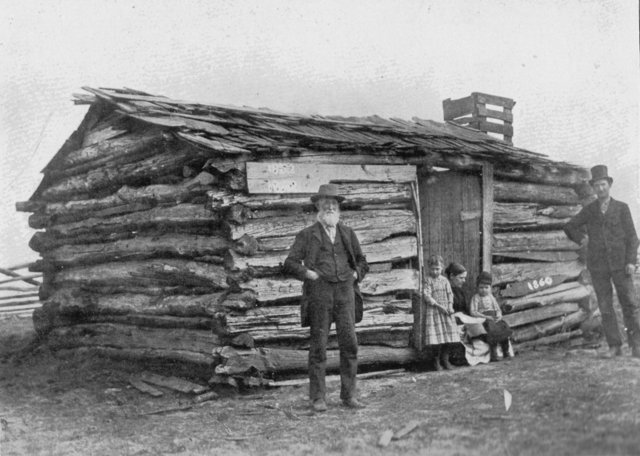
5 Ways a “History Head” Mindset Helps You Think Big
Want a secret weapon to gain more respect, get along better with others, excel at leadership, grow your business and just have more fun in life? Brush up on history.
Take it from this “history head.” A knowledge of history gives you deeper insights into yourself and others. When you become a “history head,” you gain an incalculable advantage over those who don’t have this mindset.
Here are 5 ways that becoming a “history head” will pay off and help you think big:
1. Discover the cure for the dreaded “presentism.” If you can only see the short term, you think only of the here and now. Losing all sense of perspective makes you prone to “presentism,” a sense of exaggerating present challenges out of proportion to all those challenges that have existed before.
2. Increase your odds of success. A knowledge of history is like a virtual time machine that lets you see the big picture. It’s easier to measure your current plans against things that have already occurred and weigh them against your aspirations for the future. While the nearsighted person sees only the present, and the dreamer sees only an imaginary future, often tripping over his or her mistakes trying to get there, a “history head” has a much stronger sense of reality and better chances of success.
3. Enjoy more career opportunities. History requires a complex skill set. It demands thorough research, critical thinking, and problem-solving skills. You must study and interpret a variety of sources, including politics, law, economics, sociology, psychology, the sciences and the arts, to extract meaning. These are exactly the high-level skill sets that are required in today’s top jobs.
4. Become a thought leader. Like many modern challenges in our world, history can be extraordinarily complex. In an era marred by fake news, history endows you with a healthy skepticism and a capacity to question the world around you. As you delve deeper, you almost always find unanswered questions, unclear information or missing pieces of evidence. At some point, though, you must stop researching and start developing a credible course of action. It’s like assembling a jigsaw puzzle, except there’s no picture to serve as a guide, and some of the pieces are missing. The historian, like any thought leader, must weigh the evidence, think clearly, and become a strong communicator who can express a compelling, accurate point of view.
5. Make life better. At its core, history helps you learn what it means to be human. You explore timeless issues and challenges that have impacted generations of people, both past and present. These insights equip you to better understand and work with the people in your world. Perhaps the biggest gift of all? History helps you appreciate today while building a better tomorrow.
Want more?
Thanks for stopping by. I invite you to read more of my blog posts if you want more more intriguing Iowa stories and history, along with Iowa food, recipes and tips to make you a better communicator. If you like what you see and want to be notified when I post new stories, be sure to click on the “subscribe to blog updates/newsletter” button at the top of this page. Feel free to share this information with friends and colleagues who might be interested, too.
If you’re hungry for more stories of Iowa history, check out my top-selling “Culinary History of Iowa: Sweet Corn, Pork Tenderloins, Maid-Rites and More” book from The History Press, as well as my Calhoun County” book from Arcadia Publishing, which showcases the history of small-town and rural Iowa. Order your signed copies today! Iowa postcards are available in my online store, too.
Let’s stay in touch. I’m at darcy@darcymaulsby.com, and yettergirl@yahoo.com.
P.S. Thanks for joining me. I’m glad you’re here.
@Copyright 2017 Darcy Maulsby & Co.
About me:
Some people know me as Darcy Dougherty Maulsby, while others call me Yettergirl. I grew up on a Century Farm between Lake City and Yetter and am proud to call Calhoun County, Iowa, home. I’m an author, writer, marketer, business owner and entrepreneur who specializes in agriculture. Learn more at www.darcymaulsby.com.
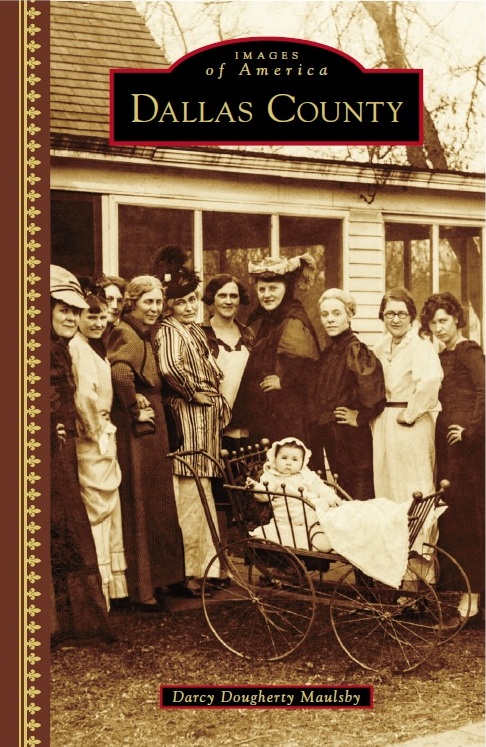
Why I’m Using a Powerful 500-Year-Old Technology to Make History–And You Can, Too
It’s always an exciting–yet nerve-wracking–moment of truth when months of research, writing and hard work end up at the one place where I have no more control—the printing press. There’s no turning back now for “Dallas County,” my third non-fiction Iowa history book, which is being printed as we speak by Arcadia Publishing, which specializes in hyper-local history. Can’t wait to show you the final result around Sept. 4!
I love the tried-and-true, old-school format of a printed, hard-cover book to share intriguing photos and the rich history of Dallas County, located just west of Des Moines. No Iowa county has influenced American history more than Dallas County. It propelled Harry Truman to an unlikely victory in the 1948 presidential campaign, following a fiery speech he delivered to 100,000 farmers on a sweltering September day at the National Plowing Match near Dexter. (Read all it about it here–along with my interview of a man who was there and took President Truman for a ride on his bulldozer!)
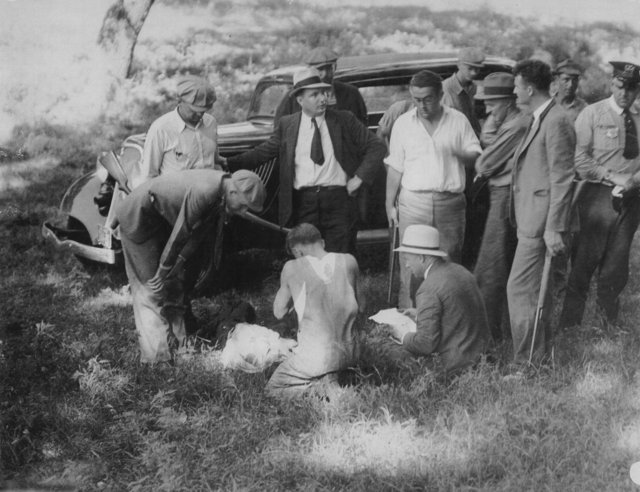
While Bonnie and Clyde escaped from the July 24, 1933, shootout with the law at the abandoned Dexfield amusement part north of Dexter, Clyde’s older brother, Buck, (shown here lying on the ground) was mortally wounded and died five days later at Kings Daughters Hospital in Perry. Buck’s wife, Blanche, was also captured at Dexfield.
Just 15 years earlier, a shoot-out near Dexfield Park marked the beginning of the end for infamous outlaws Bonnie and Clyde and the notorious Barrow Gang. (Yes, I was able to track down a lot of the crime scene photos and include them in the book, thanks to the wonderful volunteers at the terrific little Dexter Museum.)
The big-time names that have had a brush with Dallas County history don’t stop there. Dallas County has produced several major-league baseball players (among them Bob Feller and Hal Manders), a US congressman (David Young), and Nile Kinnick, the 1939 Heisman Trophy winner and University of Iowa football legend whose grandfather George Clarke, of Adel, served as Iowa’s governor from 1913 to 1917.
Today, Dallas County is one of the fastest-growing counties in America and remains a region of opportunity with a rich heritage of small-town living, farming, coal mining, and the immigrant experience. (If you like, you can pre-order the book on Amazon. If you want to wait for a signed copy, I’ll be selling them soon through my online store at my website.)
Pushing back against the dominance of digital
If you’ve got stories to share, whether for a business or for your own personal stories, why not take a look at a traditional book, or some other printed format? The print revolution is back in a big way. (Check out this great article to see what I mean.)
While digital technology swept the publishing world with the emergence of the ebook starting in 1999, inspiring some to proclaim the death of the printed book, ebook sales are plateauing. Sales of printed books are once again on the rise.
Printed books aren’t the only part of this intriguing phenomenon. Vinyl records are enjoying a rebirth, as well. This trend toward the analogue, particularly among millennials, could reflect a desire to connect to simple, tangible, non-digital things in our fast-paced, high-tech world. Perhaps it’s more of a longing to be unplugged now and then and occasionally tuned out. Whatever it foretells, the news that printed books are back is welcome here!
Want more?
Thanks for stopping by. I invite you to read more of my blog posts if you want more more intriguing Iowa stories and history, along with Iowa food, recipes and tips to make you a better communicator. If you like what you see and want to be notified when I post new stories, be sure to click on the “subscribe to blog updates/newsletter” button at the top of this page. Feel free to share this information with friends and colleagues who might be interested, too.
 If you’re hungry for more stories of Iowa history, check out my top-selling “Culinary History of Iowa: Sweet Corn, Pork Tenderloins, Maid-Rites and More” book from The History Press, as well as my Calhoun County” book from Arcadia Publishing, which showcases the history of small-town and rural Iowa. Order your signed copies today! Vintage and rural Iowa postcards are available in my online store, too.
If you’re hungry for more stories of Iowa history, check out my top-selling “Culinary History of Iowa: Sweet Corn, Pork Tenderloins, Maid-Rites and More” book from The History Press, as well as my Calhoun County” book from Arcadia Publishing, which showcases the history of small-town and rural Iowa. Order your signed copies today! Vintage and rural Iowa postcards are available in my online store, too.
Let’s stay in touch. I’m at darcy@darcymaulsby.com and yettergirl@yahoo.com.
P.S. Thanks for joining me. I’m glad you’re here.
@Copyright 2017 Darcy Maulsby & Co.
About me:
Some people know me as Darcy Dougherty Maulsby, while others call me Yettergirl. I grew up on a Century Farm between Lake City and Yetter and am proud to call Calhoun County, Iowa, home. I’m an author, writer, marketer, business owner and entrepreneur who specializes in agriculture. Learn more at www.darcymaulsby.com.

Lightner on Leadership: “Everyone Has Something to Give”
My friend Deb Lightner calls it her ah-ha moment. While she was well acquainted with Stewart Memorial Community Hospital (SMCH) in Lake City through her 12 years of service on the hospital board, it became personal when a good friend received care at SMCH.
“My friend received a survey from SMCH and was asked if there were any staff members she’d like to lift up for special recognition,” said Lightner of Lohrville, whose friend had been diagnosed with breast cancer. “My friend said she couldn’t single out any one person, because they were all wonderful.”
This experience highlighted the value of compassionate care close to home and reinforced Lightner’s commitment to SMCH, where she served on the board from 2005 to her retirement this spring.
“It’s wonderful to have access to high-quality healthcare in our community. Having SMCH here also does so many other good things for our area, from attracting medical and business professionals to providing good jobs. Our communities also benefit when people connected with SMCH fill leadership roles, from city councils to school boards.”
Lightner is a true servant leader, said Cynthia Carstens, president/CEO of SMCH. “Deb has the skills, knowledge and heart to tackle challenges and make sure that needs are addressed. She adheres to the principles of listening, empathy, foresight, shared decision making, a willingness to challenge the status quo and building community.”
Carstens cited how Lightner recognized a need for a Meals on Wheels program for the Lohrville community. “She worked with our organization to get that set up and delivered many of those meals herself until there no longer was a need.”
Five ways SMCH is raising the bar
This spirit of service is reflected throughout SMCH, a critical access hospital affiliated with UnityPoint Health. Lightner is proud that SMCH is raising the bar in five keys ways, including:
1. Culture change. SMCH worked with the Studer Group® to build a sustainable culture that promotes accountability, fosters innovation and consistently delivers a great patient experience. This culture helps attract top talent to SMCH, a non-profit organization that employs approximately 185 full-time staff in Lake City, Lake View, Rockwell City and Gowrie. “Other hospitals around Iowa are amazed at SMCH’s ability to recruit doctors and other medical professionals,” Lightner said.
2. Diverse leadership. Strong leadership is the key to any successful organization, said Lightner, who farms with her family near Lohrville. Along with the SMCH leadership team, the SMCH board includes people with a diverse array of skills. “The board has included farmers, educators, pastors, small-business owners, bank presidents and others who care about the community and the organization,” Lightner said. “Good board members also show a willingness to learn, ask questions and speak up.”
3. Inclusion. While Lightner encourages people to serve on the SMCH board, there are other ways to get involved. SMCH offers a hospital auxiliary group where members can volunteer at the SMCH gift shop, help with fundraising events and more.
4. Responsive solutions. Wellness and preventative healthcare are priorities at SMCH. “Many of SMCH’s Lunch Connection educational programs and other wellness programs are developed in response to issues the community cares about,” Lightner said.
5. Forward focus. As medical technology advances and outpatient services become much more prevalent, this presents complex, challenging issues for the hospital, said Lighter, who has a strong background in finance. “While we’re still one of the hospitals that delivers babies, the trend away from in-patient care means SMCH is looking at new ways to best serve our community and do it cost-effectively.”
Lightner remains a strong supporter of SMCH, even though her board term is completed. “It has been an honor to work with Deb, who is one of the strongest women I know,” Carstens said.
Lightner is currently exploring volunteer opportunities with the Peace Corps. “I never view community service as a chore,” she said. “Everyone has something to give.”
This originally appeared in the Hometown Pride section of the Fort Dodge Messenger, June 25, 2017.
Want more?
Thanks for stopping by. I invite you to read more of my blog posts if you want more more intriguing Iowa stories and history, along with Iowa food, recipes and tips to make you a better communicator. If you like what you see and want to be notified when I post new stories, be sure to click on the “subscribe to blog updates/newsletter” button at the top of this page. Feel free to share this information with friends and colleagues who might be interested, too.
If you’re hungry for more stories of Iowa history, check out my top-selling “Culinary History of Iowa: Sweet Corn, Pork Tenderloins, Maid-Rites and More” book from The History Press, as well as my Calhoun County” book from Arcadia Publishing, which showcases the history of small-town and rural Iowa. Order your signed copies today! Iowa postcards are available in my online store, too.
Let’s stay in touch. I’m at darcy@darcymaulsby.com, and yettergirl@yahoo.com.
P.S. Thanks for joining me. I’m glad you’re here.
@Copyright 2017 Darcy Maulsby & Co.
About me:
Some people know me as Darcy Dougherty Maulsby, while others call me Yettergirl. I grew up on a Century Farm between Lake City and Yetter and am proud to call Calhoun County, Iowa, home. I’m an author, writer, marketer, business owner and entrepreneur who specializes in agriculture. Learn more at www.darcymaulsby.com.

Imagine That! Writers, Put Your Reader Right in the Action
“Picture this – you’re boarding a plane headed to an exotic or historic destination, like Rome or Dubai. You settle into your roomy business or first-class seat and the best part is, you didn’t have to pay for any of this. Sound too good to be true? Not if you were a United States Agency for International Development (USAID) employee between at least 2012-2014.”
Bet this hooked you, even if you’ve never heard of the USAID, right?
I knew nothing about the USAID, but I couldn’t resist scanning the e-mail when I read, “Picture this—you’re on a plane….” It put me right in the middle of the story, right from the start, and I wanted to know how the story ends.
That’s how you hook a reader, my friends. Craft your story so the audience sees themselves in it. It’s possible, even with a potentially dry, obscure topic.
Yes, even a press release can stir emotion
Would you be surprised to know this powerful writing example came from a press release issued by a politician from Iowa?
The release went on to detail documents revealing that “USAID employees have been purchasing business or first-class tickets for years, racking up nearly $3.1 million in taxpayer dollars on extravagant plane travel between 2012 and 2014.”
In the hands of less skilled writer, the title or lead of this news release could have been “Senator Questions USAID Deluxe Travel Expenses.” It would have been accurate, but boring. Most readers (myself included) probably have no idea what the USAID is. Game over, because we quit reading and move on. There’s nothing here of interest, right?
Think again.
Like millions of other Americans, I do care about wasteful spending of my tax dollars. I’m glad to know at least some of my elected officials are monitoring potential abuses of the system and are working to find solutions.
I won’t know this, however, if my elected officials aren’t communicating in a way that’s clear and compelling.
Now that I’ve pictured myself on settling in to a first-class seat on a plane bound for an exotic or historic destination—and I didn’t have to pay for any of this—I’m frustrated when I read that “one USAID employee took a $15,000 business-class trip, when the same trip would have only cost $3,000 if the employee had flown coach.”
This feeling of frustration isn’t something that lackluster writing provokes. Words that not only convey truth but stir emotion are a sign of a story well told.
Show, don’t tell
That’s the beauty of the “picture this” storytelling technique. It’s an effective way for authors, marketers and other writers to fulfill the age-old writing advice to “show, don’t tell.”
Sometimes I switch up the words a bit and lead with “Imagine this,” but the goal is still the same. Capture readers’ imaginations. Place them right in the center of the action. Motivate them to keep reading. It’s a powerful tool to that will propel you beyond the ranks of boring writers who fail to hold readers’ attention.
Imagine that!
What do you think?
Have you tried using the “picture this” or “imagine this” lead? Any other good tips for capturing your readers’ attention from the start? I welcome your comments and stories.
Want more?
Thanks for stopping by. I invite you to read more of my blog posts if you want more tips to make you a better communicator, along with intriguing Iowa stories, history and recipes. If you like what you see and want to be notified when I post new stories, be sure to click on the “subscribe to blog updates/newsletter” button at the top of this page. Let’s stay in touch. I’m at darcy@darcymaulsby.com.
P.S. Thanks for joining me. I’m glad you’re here.
@Copyright 2017 Darcy Maulsby & Co.
In the meantime, perhaps you’ll find value in my Top 10 Tips to Find the Right Writer to Tell Your Company’s Stories.
Top 10 Tips to Find the Right Writer to Tell Your Company’s Stories
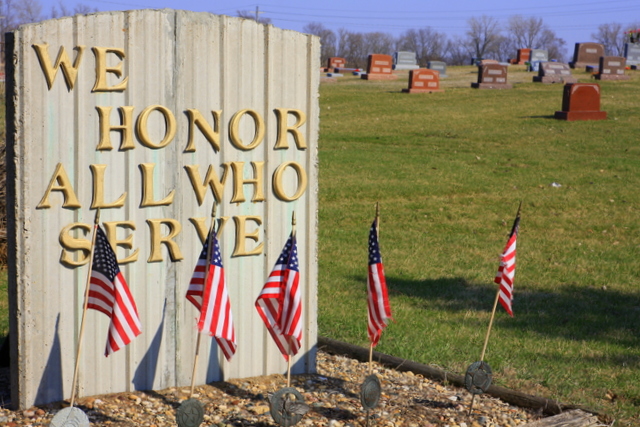
How to Thank Veterans for Their Military Service
It shocked me the first time it happened. I was sitting in the living room of a World War 2 veteran and was interviewing him for a Memorial Day story. I felt humbled and grateful to hear his stories as he described the places he’d served, the hardships he had experienced, his fears and his perspective on life all these years later. What stunned me was his family’s reaction.
“That’s the first time I’ve heard most of those stories,” said his daughter who had stopped by during the interview.
This wouldn’t be the first time I’d have this experience. I’ve discovered that sometimes veterans won’t open up, even to loved ones, because the memories are too painful, but sometimes the reasons are much simpler. “I tried sharing these stories a few times, but my family didn’t really understand what I was talking about and didn’t ask any questions, so I just gave up,” one Iowa veteran told m e. “I decided it would be easier to talk about these things with other veterans.”
e. “I decided it would be easier to talk about these things with other veterans.”
This got me thinking—what’s the right way to talk to veterans, whether you want to thank them or hear more of their stories? If you’re like me, maybe you’re not even sure how to start the conversation.
That’s why I asked Marine Corps veterans James Nash and Jay Lippmeier for their insights. I first connected with Nash and Lippmeier after they came to Lakota, Iowa, for Hunting with Heroes. This amazing program, which was created by Bernie and Jason Becker, invites Marines from the Wounded Warrior Battalion at Camp Lejeune, North Carolina, to the Midwest each November for an all-expenses-paid trip to find some peace in the Iowa countryside and enjoy some prime pheasant hunting.
Captain Nash is now retired from the Marine Corps and lives in Oregon. He enjoys returning to Iowa to help create a sense of camaraderie and comfort for the Marines who participate in Hunting with Heroes for the first time. Staff Sergeant Lippmeier, who participated in the 2016 Hunting with Heroes event, is a Cincinnati, Ohio, native who recently retired from the Marines Corps and appreciates the chance to spend more time with his family, including his children.
I’d like to thank Captain Nash and Staff Sergeant Lippmeier for their friendship and for letting me share their insights in my May 26, 2017, Farm News column, which I’m also sharing here:
Q: Any tips on what people can say to veterans to start the conversation?
Nash: When folks say thanks for your service, it does two things to me. I typically sense their gratitude, but I also sense that sometimes people issue that canned phrase to reassure their sense of patriotism to themselves, and they are not interested in what exactly it is they’re thanking me for.
When I talk to vets, I ask then what branch they were in and what their job was. Army vets often respond with a numerical designation for their military occupational specialty (MOS), like 11B. That’s fine, but ask what that means, where were they stationed, what unit did they serve with? Did they deploy? Do they still keep in touch with anyone they served with?
If these questions don’t begin a conversation, the veteran likely doesn’t want to talk. Respect that. That’s the time to end the conservation and say thank you. It won’t be hollow because, now you both know what you are thanking the veteran for.
Lippmeier: Treat veterans like other people you’ve just met. Ask them what they do/did in the military, like their branch of service and their military occupation. Then use follow-up questions, especially if you don’t understand the answers or certain verbiage the military uses. I would much rather explain something to someone than have them have no clue what I’m talking about.
Upon first meeting someone, most vets I know have no problem talking about what branch they were in or what job they did without going into a lot personal details. Most vets will start to open up a bit as they get more comfortable. If someone doesn’t want to talk about his or her service, respect that. Everyone has bad days sometimes.
Q: Are there any things people shouldn’t ask?
Nash: I don’t like when folks asked me how many people I killed. It’s not like I wrote hash marks in my journal. But if they do ask, that’s better than if they are afraid to ask. When I sense people don’t have the courage to ask about my experiences, it makes me compare that lack of courage to the bravery I witnessed in the men I served with. Then I wonder why we risked so much for that person’s freedom.
I remember that it’s always incumbent upon the brave to protect the fearful, for a few to sacrifice for the many, but it doesn’t feel good when I compare the fear of driving through a minefield, getting shot at by snipers or having mortars explode around me to someone’s fear of simply asking me what that was like.
Lippmeier: The number one question people shouldn’t ask is, “Have you ever killed anyone?” That is by far the question I ‘ve been asked the most, and it’s definitely a loaded question and a very personal one, as well.
Besides that, most vets will let you know if they don’t want to answer a certain question, or they may shut down if a question strikes a nerve. Again, just respect that and move on. I’m sure there are questions that would make anyone uncomfortable, so just use your best judgment and treat vets with the same respect you would treat any person you just met.
Q: Are there any things you wish people knew about the military or veterans?
Nash: Not every service member experiences combat. Most don’t. It’s important to not discount their sacrifice in the time they spend away from their loved ones and the relative hazards to their job. Also, when it comes to injuries, you must understand that paralysis and amputations are dramatic, but many injuries are unseen. A lot of folks look at me and say things like, “Well, it looks like you are doing just fine.” To which I think, yeah, it’s just my brain and spine that were damaged. No big deal. But I don’t say that.
Lippmeier: The biggest thing that I wish people knew is that everyone’s military experience will vary. Just because someone was in the military doesn’t mean they were in combat. The majority of veterans don’t see combat, but just because a vet wasn’t in combat doesn’t make their service less honorable. Without vets that didn’t see combat, the combat guys wouldn’t be able to do their jobs.
Another thing is that not all injuries are visible. You can spot guys who are missing limbs or using wheelchairs or other devices, but the majority of vets who are injured have “invisible wounds.” Just because I have 10 fingers and 10 toes doesn’t mean I don’t have five herniated discs, scar tissue in my brain, severe post-traumatic stress disorder, and a laundry list of other injuries. So just realize there can be a plethora of things going on with someone even though he or she looks ok.
Q: Any other tips for how civilians can communicate better with veterans?
Lippmeier: Treat veterans like normal people, but realize they’ve had a lot of different experiences than non-vets. Just be patient, and veterans will usually open up after some time. It’s sometimes hard for veterans to let someone in their life, because they may have seen or had someone close to them be violently torn from their life.
Nash: Know that if you ask these questions, the answers may make you uncomfortable. Try to compare your discomfort with the experience of the person you are speaking to, and hopefully it will give you the guts the hang in there and have the conversation. Let veterans know their sacrifices were worth the cost.
I salute our veterans
I salute America’s military men and women, including Captain Nash and Staff Sergeant Lippmeier, and am forever grateful to those who trust me enough to share their stories. We must never forget their service and their sacrifices. (Click here to hear Captain Nash, in his own words, talk about everything from hunting to his experiences as an officer to being awarded the Purple Heart.)
Some veterans will tell you that Veterans’ Day is the time to member those who survived, while Memorial Day is to honor those who have died. That’s true, yet Memorial Day to me means a time to honor all our military personnel, including those who have passed away, veterans who are still with us and those serving on active duty.
A respect for all veterans was instilled in me from childhood as my parents took me each May to the Lake City Cemetery for the Memorial Day service. The roll call of the deceased is one of the most poignant parts of the service. As I listen for the name Henry C. Nicholson, an ancestor of mine who fought in the Civil War, I also glance around the crowd and see the veterans who are still with us. These men and women are my friends and neighbors who came back to Iowa to farm, work hard, raise a family and give back to their community. These are the everyday people who make America work.
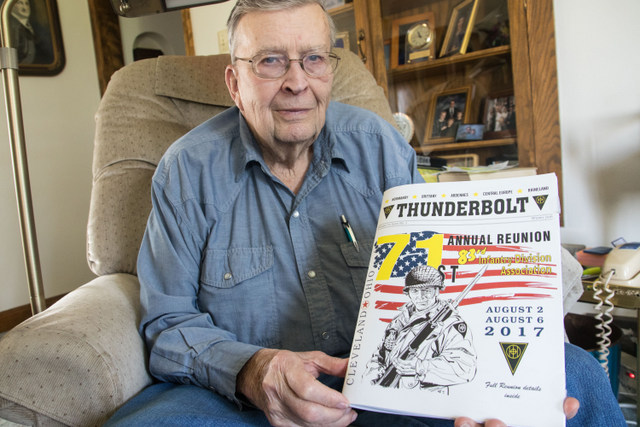
Harold Geisinger, 91, of Storm Lake, Iowa served in Europe in the U.S. Army during World War 2. This retired farmer continues to help on his family’s farm north of Storm Lake.
“Thank God it’s over”
Most of these veterans are humble, unassuming people, like Harold Geisinger of Storm Lake. I was honored to sit down with this World War 2 veteran this May. What started as as interview about his family’s Buena Vista County Century Farm turned into an unforgettable conversation about his service in the U.S. Army in the waning days of World War 2. Here’s a sample of his story, which I originally wrote for Farm News:
While V-E Day (Victory in Europe) was proclaimed “the celebration heard ‘round the world,” it was only a temporary reprieve for Harold Geisinger. This 19-year-old Iowa farm boy from Storm Lake was on his way to Le Havre, France, with the U.S. Army when Germany surrendered unconditionally to the Allies on May 7, 1945.
After a low-key celebration, Geisinger and his fellow soldiers boarded a box car in France bound for Hanover, Germany. Geisinger then joined a convoy in Bavaria, the section of Germany where American troops were guarding railroads, train depots, irrigation sites and more.
While the war was over in Europe, fighting continued on the other side of the globe. In the summer of 1945, there was talk that Geisinger and his fellow soldiers would likely be on board the next U.S. military ship bound for the Pacific Theater. Everything changed, however, when Japan surrendered on Sept. 2, 1945, following President Harry S. Truman’s orders to drop two atomic bombs on Japan in August 1945.
“When we got the word that Japan quit, we didn’t celebrate,” said Geisinger, 91, who still gets tears in his eyes when he thinks back to those days nearly 72 years ago. “We simply sat down and said, ‘Thank God it’s over.’”
Read off of Harold’s remarkable story here.
 Want more?
Want more?
Thanks for stopping by and listening to these stories. I invite you to read more of my blog posts if you want more Iowa stories, history and recipes, as well as tips to make you a better communicator. If you like what you see and want to be notified when I post new stories, be sure to click on the “subscribe to blog updates/newsletter” button at the top of this page. Let’s stay in touch.
P.S. Thanks for joining me. I’m glad you’re here.
@Copyright 2017 Darcy Maulsby & Co.



